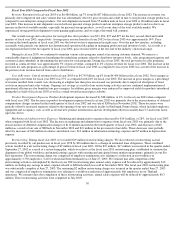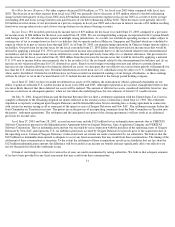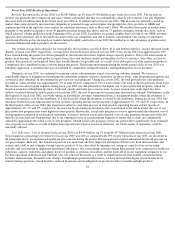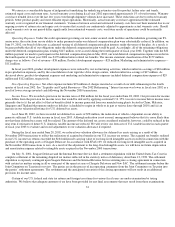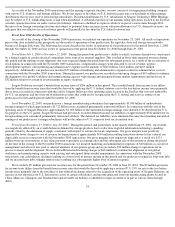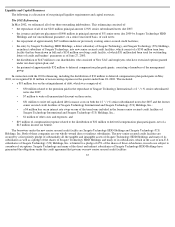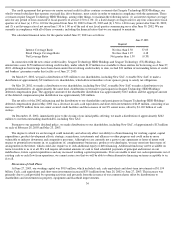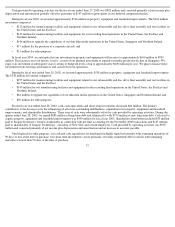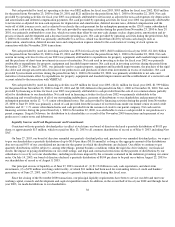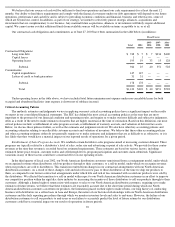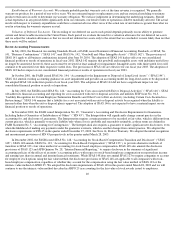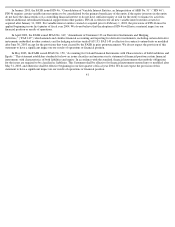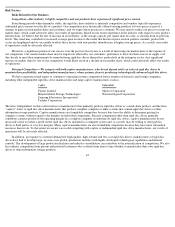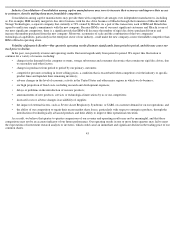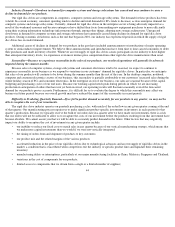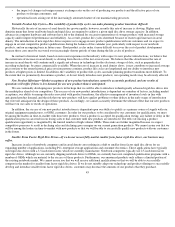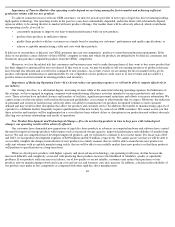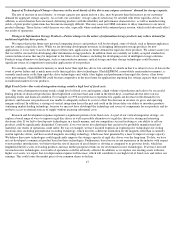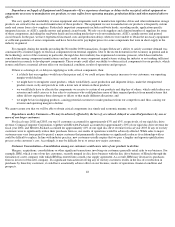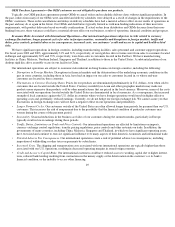Seagate 2002 Annual Report Download - page 44
Download and view the complete annual report
Please find page 44 of the 2002 Seagate annual report below. You can navigate through the pages in the report by either clicking on the pages listed below, or by using the keyword search tool below to find specific information within the annual report.
We believe that our sources of cash will be sufficient to fund our operations and meet our cash requirements for at least the next 12
months. Our ability to fund these requirements and comply with the financial covenants under our debt agreements will depend on our future
operations, performance and cash flow and is subject to prevailing economic conditions and financial, business and other factors, some of
which are beyond our control. In addition, as part of our strategy, we intend to selectively pursue strategic alliances, acquisitions and
investments that are complementary to our business. Any material future acquisitions, alliances or investments will likely require additional
capital. We cannot assure you that additional funds from available sources will be available on terms acceptable to us, or at all.
Our contractual cash obligations and commitments as of June 27, 2003 have been summarized in the table below (in millions):
Under operating leases in the table above, we have included total future minimum rent expense under non-cancelable leases for both
occupied and abandoned facilities (rent expense is shown net of sublease income).
Critical Accounting Policies
Fiscal Year(s)
Total
2004
2005-
2006
2007-
2008
After
2008
Contractual Obligations:
Long term debt
$
748
$
5
$
7
$
336
$
400
Capital leases
1
1
—
—
—
Operating leases
195
19
33
15
128
Subtotal
944
25
40
351
528
Commitments:
Capital expenditures
147
147
—
—
—
Letters of credit or bank guarantees
31
31
—
—
—
Subtotal
178
178
—
—
—
Total
$
1,122
$
203
$
40
$
351
$
528
The methods, estimates and judgments we use in applying our most critical accounting policies have a significant impact on the results
we report in our consolidated financial statements. The SEC has defined the most critical accounting policies as the ones that are most
important to the portrayal of our financial condition and operating results, and require us to make our most difficult and subjective judgments,
often as a result of the need to make estimates of matters that are highly uncertain at the time of estimation. Based on this definition, our most
critical policies include: establishment of sales program accruals, establishment of warranty accruals, and valuation of deferred tax assets.
Below, we discuss these policies further, as well as the estimates and judgments involved. We also have other key accounting policies and
accounting estimates relating to uncollectible customer accounts and valuation of inventory. We believe that these other accounting policies
and other accounting estimates either do not generally require us to make estimates and judgments that are as difficult or as subjective, or it is
less likely that they would have a material impact on our reported results of operations for a given period.
Establishment of Sales Program Accruals. We establish certain distributor sales programs aimed at increasing customer demand. These
programs are typically related to a distributor’s level of sales, order size and advertising or point of sale activity. We provide for these contra-
revenues at the time that revenue is recorded based on estimated requirements. These estimates are based on various factors, including
estimated future price erosion, customer orders and sell-through levels, program participation and customer claim submittals. Significant
variations in any of these factors could have a material effect on our operating results.
In the third quarter of fiscal year 2002, our North American distribution customers transitioned from a consignment model, under which
we recognized revenue when distributors sold our products through to their customers, to a sell-in model, under which we recognize revenue
when our products are sold to distributors. This transition resulted from changes in our contractual arrangements with our North American
distribution customers. As a result of these changes, title and risk of loss now pass to those distributors at the time we ship our products to
them, as compared to our former contractual arrangements under which title and risk of loss remained with us until our products were sold by
the distributors. We effected the transition to a sell-in model with respect to our North American distribution customers in an effort to improve
our competitive position within the rigid disc drive industry by increasing the incentive of those distributors to sell our products through to their
customers. Although a limited right of return exists with respect to sales to our North American distribution customers, requiring us to make
estimates of future returns, we believe that these estimates are reasonably accurate due to the short time period during which our North
American distribution customers can return our products, the limitations placed on their right to make returns, our long history of conducting
business with distributors on a sell-in basis in Asia and Europe, the nature of our historical relationships with our North American distribution
customers and the daily reporting procedures through which we monitor inventory levels and sales to end-users. However, the failure of our
distribution customers to sell our products to end-users or our failure to accurately predict the level of future returns by our distribution
customers could have a material impact on our results of operations in future periods.
39



